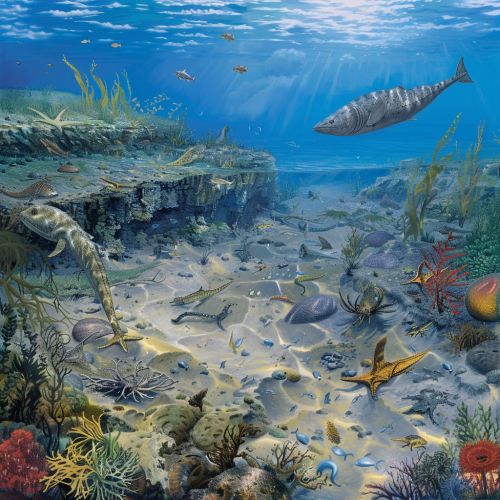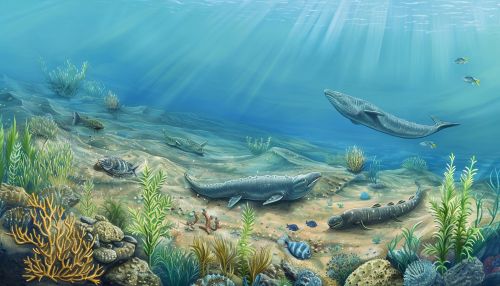Paleozoic
Introduction
The Paleozoic (or Palaeozoic) Era, meaning "ancient life", is a significant period in the geological history of the Earth. Spanning from approximately 541 to 252.17 million years ago, it is the earliest of three geologic eras of the Phanerozoic eon, succeeded by the Mesozoic and Cenozoic eras.


Periods of the Paleozoic Era
The Paleozoic era is subdivided into six geologic periods: the Cambrian, Ordovician, Silurian, Devonian, Carboniferous, and Permian. Each of these periods is characterized by unique evolutionary milestones, climatic conditions, and geological events.
Cambrian Period
The Cambrian period, spanning from 541 to 485.4 million years ago, marks the beginning of the Paleozoic era. This period is notable for the Cambrian Explosion, a significant event in the history of life on Earth, where most of the major groups of animals first appeared in the fossil record.
Ordovician Period
The Ordovician period, from 485.4 to 443.8 million years ago, is characterized by the diversification and expansion of early marine life. The end of this period is marked by the first of five major mass extinctions in Earth's history, known as the Ordovician-Silurian extinction event.
Silurian Period
The Silurian period, from 443.8 to 419.2 million years ago, saw significant evolutionary developments, including the appearance of the first land plants and the first terrestrial arthropods.
Devonian Period
The Devonian period, from 419.2 to 358.9 million years ago, is often referred to as the "Age of Fishes" due to the diversification of fish. The first seed-bearing plants appeared during this period, marking a significant development in the evolution of terrestrial life.
Carboniferous Period
The Carboniferous period, from 358.9 to 298.9 million years ago, is known for its vast coal deposits, which formed from the remains of plants that dominated the land during this period. The first amniotes, a group of tetrapods that includes the ancestors of all modern reptiles, birds, and mammals, also appeared during the Carboniferous period.
Permian Period
The Permian period, from 298.9 to 252.17 million years ago, ended with the largest mass extinction in Earth's history, the Permian-Triassic extinction event, which wiped out nearly 96% of marine species and 70% of terrestrial species.
Paleozoic Life
The Paleozoic era witnessed dramatic evolutionary changes in life on Earth. The era began with the Cambrian explosion, during which most of the major groups of animals first appear in the fossil record. This era also saw the first vertebrates, the evolution of fish, the emergence of land plants and terrestrial arthropods, and the development of complex ecosystems both on land and in the oceans.
Paleozoic Climate
The climate of the Paleozoic era was quite varied. During the Cambrian period, the Earth was generally warm, without widespread ice caps. However, the climate cooled during the Ordovician period, leading to widespread glaciation and a major extinction event. The climate again warmed during the Silurian and Devonian periods, only to cool once more during the Carboniferous period, leading to another glaciation event. The Permian period saw a warming trend, ending with the largest mass extinction in Earth's history.
Paleozoic Geography
The geography of the Paleozoic era was dynamic and underwent significant changes due to the movement of Earth's tectonic plates. The era began with most of the Earth's landmasses clustered together as a supercontinent called Rodinia. Throughout the Paleozoic, Rodinia broke apart and the fragments eventually reassembled to form another supercontinent, Pangea, by the end of the era.
Conclusion
The Paleozoic era, spanning over 290 million years, was a time of significant change on Earth. It saw the emergence and diversification of life, significant shifts in climate, and the dynamic movement of continents. The study of this era provides crucial insights into the history of our planet and the evolution of life.
